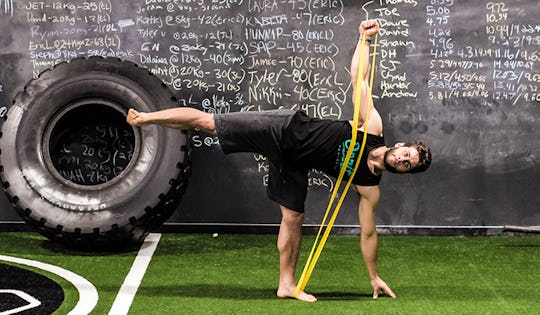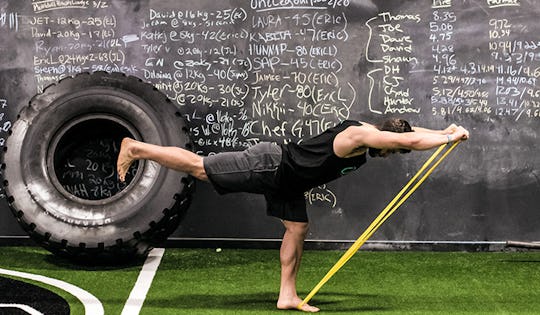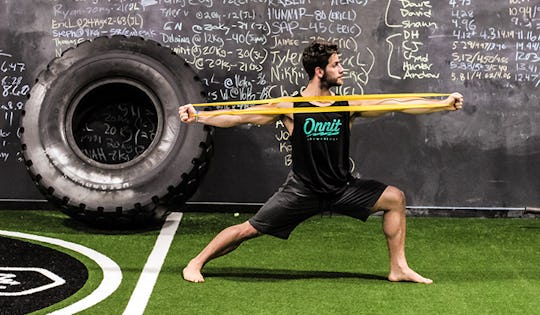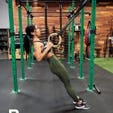Resistance Bands allow for more tension than is normally accessible in your yoga poses. This additional tension provides scalable difficulty and an alternative perspective on yoga poses that we normally practice without resistance. Add resistance bands to your most typical yoga poses to gain that extra engagement towards your practice!
Resistance Band Yoga Pose #1: Half Moon

Balancing in an open hip pattern is tough, using extreme strength in the hip joint capsule to do so. The Half Moon exercise is a great activator of the external hip rotators on the balancing leg, creating openness in the muscles on the inside of that same leg. At the same time, trunk stabilization is required to try and keep the geometry straight through the top side of this yoga pose.
Adding a resistance band to the top hand and bottom foot will create a more dynamic balancing effort in this balancing practice. Similar to Warrior 2, more engagement is required to keep an expansive chest. The Quadradus Lomborum is a spinal stabilizer that is heavily active in the body weight variation of this yoga pose, and when the tension of the resistance band pulls down on the upper body, this muscle is heavily activated.
Resistance Band Yoga Pose #2: Warrior 3

This balancing yoga pose requires a strong single leg engagement to balance and a responsive spinal extension action to reach forward. As these two forces pull on each other, Warrior 3 strengthens the engagement of both, building better single leg strength and thoracic extension.
Adding the resistance band creates a super-gravity effect on the upper body, requiring a stronger response of spinal muscles to stretch out and lengthen through the arms. This additional tension will engage those muscles involved with correct posture and spinal function even more than the yoga pose without a resistance band.
Resistance Band Yoga Pose #3: Wide Legged Forward Fold

Folding with wide legs is essential to reducing the tension that can be tucked away in the adductor muscles after an intense session. Several different arm variations are available in this fold, however the most effective that I have felt is with the arms up and behind the spine. A massive release can be felt in the middle back when folding with this arm variation.
Many times, this variation is not accessible due to a limited range of motion in the shoulders. Adding the resistance band takes away that limitation and allows for the overhead arm variation to be accessible to even the most tight of shoulders!
Resistance Band Yoga Pose #4: Warrior 2

Expansion of the chest cavity in this yoga pose is so crucial to correct posture and torso strength. Coupled with adducting the separated legs, Warrior 2 is a powerful yoga pose that builds an understanding of the body as one complete unit. The resistance band allows for the angles of tension to be altered in Warrior 2, providing the opportunity for a different exploration of this full body movement.
By holding one end of the resistance band in either hand, a more robust contraction of the middle back muscles is required to keep the same open chest. In addition, the resistance band provides a marker of how level each arm is with one another, an especially difficult task when one hand is completely outside the range of vision.
Resistance Band Yoga Pose #5: Chair

 A great exercise of spinal strength, chair requires openness through the front side of the torso while deepening the bend into the legs.
A great exercise of spinal strength, chair requires openness through the front side of the torso while deepening the bend into the legs.
Most importantly, the weight of chair pose is back in the heels, allowing for accessible stacking of the vertebra to create shoulder over hip alignment.
Sometimes, the range of motion in the shoulders limits the ability to take the arms up and overhead.
Adding a resistance band will increase the amount of tension taking the arms back and allow for an easier stack of the shoulders over the hips.
With this alignment, the abdominal wall is ready to be engaged in order to straighten out and lengthen through the entire spine while still bending low into the legs.

)





